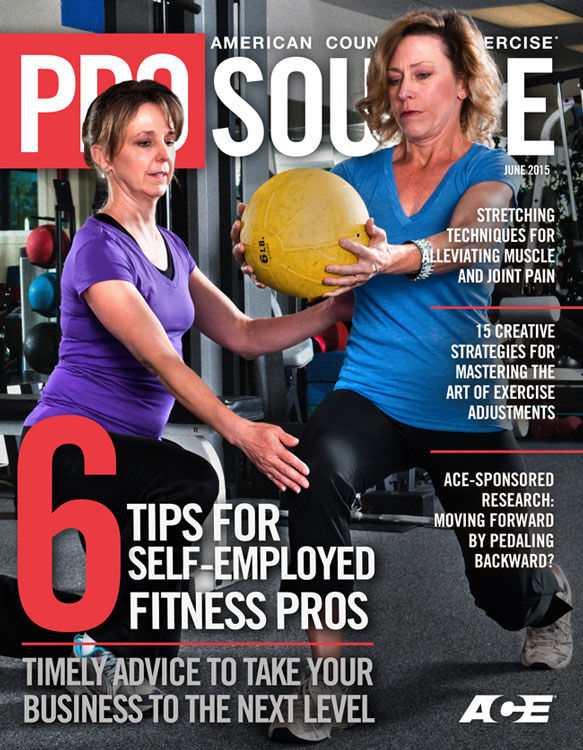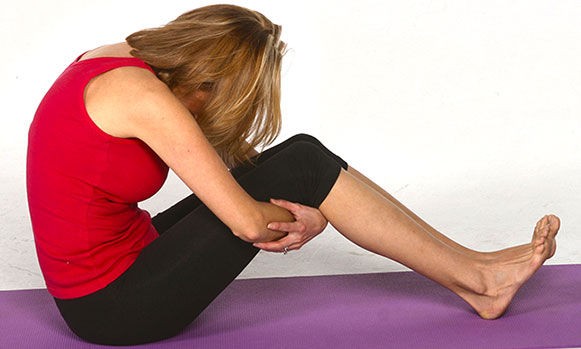
Chronic muscle and joint pain is a common and often debilitating problem for many people, making it difficult, if not impossible, to adhere to a program of regular exercise. As a health and fitness professional, many of your clients undoubtedly turn to you for help in managing this chronic pain. This three-part series was designed to help you integrate corrective exercise strategies into your client programs. While part 1 focused on how to develop and implement a self-myofascial release (SMR) program to successfully help clients alleviate muscle and joint pain, this current installment demonstrates how to progress your corrective exercise strategies. It also covers how to know when it is appropriate to incorporate stretching exercises with clients who are experiencing musculoskeletal pain. Part 3 describes how to evolve your pain-relief programs further by incorporating the most effective corrective strengthening techniques.
When to Use Stretching Exercises in Corrective Exercise Programs
Every corrective exercise program should begin with the introduction of SMR techniques, progress to stretching and, ultimately, incorporate strengthening exercises (American Council on Exercise, 2014). Once you have assisted your clients in addressing any major myofascial restrictions they might have with appropriate SMR techniques, it is time to introduce effective stretching exercises into their corrective exercise programs. This marks the beginning of retraining the way your clients move by increasing range of movement and the mobility they experience when performing both daily activities and the movements required in their chosen activities and sports.
Types of Stretching Exercises
There are many different stretching techniques. The three most widely used are categorized as passive/static, active and dynamic (Blahnik, 2011). Each technique offers a unique benefit to clients as they prepare for the next stage of their corrective exercise program.
Passive/Static Stretching
Passive stretching involves holding a static position (with assistance from something like your hand, a yoga strap, the wall, the ground or another person) for a predetermined amount of time to encourage increased range of movement around a joint or number of joints. This type of stretching is very useful in the early stages of a client’s stretching program. It enables individuals to control the elongation of a muscle (or group of muscles) and helps build confidence in relearning movements that may have been avoided due to pain and/or injury. A standing calf stretch is an example of a passive stretch (see Calf Stretch in the sample program below).
Active Stretching
Active stretching requires your client to hold the target muscle(s) in a stretch position while simultaneously contracting the antagonist or opposing muscle(s). It is a great way to begin integrating different functions of muscles or muscle groups to work together to mimic how the body works while in motion (Price, 2010). Activating (or contracting) the gluteus maximus muscle to facilitate a better stretch of the hip flexors is an example of an active stretching exercise (see Hip-flexor Stretch in the sample program below).
It is crucial to develop a thorough understanding of anatomy so you can identify which muscle or muscle groups need to contract in order for the opposing group to stretch.
Dynamic Stretching
Dynamic stretches are used to mimic real-life movements. They involve the use of multiple muscles contracting to move any number of bones while other muscles lengthen to allow motion of these body parts to occur. This type of stretching helps clients learn to perform a desired movement while still being observed and coached in a controlled and coordinated manner. The Step Back with Arm Raise stretch (described in the sample program below) is an example of a dynamic stretch.
The Benefits of Stretching
When combined with a program of self-massage, stretching is an effective tool for releasing excess tension from muscles and fascia, increasing overall tissue health and promoting repair, decreasing stress and increasing range of movement. Additionally, stretching can further warm up tissues to prepare muscles and joints for more complex movements and decrease the risk of potential injury.
Stretching also involves moving the body in directions that mimic the way the body should move when it is working properly. Therefore, correctly performed stretches are vital for re-educating the nervous system about pain-free movement. They also help set the stage for progressing the neuromuscular system into the strengthening phase of a corrective exercise program (Price, 2010).
Developing a Stretching Program
Which muscles need stretching?
The key to knowing which muscles need stretching is to perform a series of systematic posture and structural assessments during your initial consultations with clients to identify any bony structures that are misaligned, immobile or not functioning as they should (American Council on Exercise, 2014). You can then utilize these assessment results to identify those muscles that attach to or influence those bony structures to determine what needs to be addressed as part of your corrective stretching program. For example, if your postural assessment reveals that your client has excessive lumbar lordosis (i.e., an overarching of the lower back), you could incorporate (among other exercises) a stretch for the back extensors to help promote better lumbar spine flexion (see Lower-back Stretch in the sample program below).
Another way to ascertain what muscles need stretching is to ask your client during the initial consultation about past or current injuries, habitual movement patterns and activities, work environments, postural habits, diagnoses of degenerative changes, and disease that might be affecting the health and function of various soft-tissue structures. For example, if you note that your client spends most of the day seated at a computer in hip flexion, then a stretch to help promote better hip extension would be a beneficial addition to his or her program (see Hip-flexor Stretch in the sample program below).
You can also use feedback from your client’s SMR program to identify which muscles are restricted or need additional help with specific and targeted stretches. For example, if your client reports a lot of muscle tension or discomfort while performing an SMR technique for the lower back, incorporating a lower-back stretch (see sample program below) into his or her program could help improve the health and elasticity of those tissues.
Which specific stretching exercises should you recommend?
When designing a corrective exercise-stretching program, you must evaluate which specific soft-tissue structures need addressing to correct any underlying musculoskeletal imbalances you have identified. For example, if your client presents with a rounded upper back and shoulders (i.e., excessive thoracic kyphosis), consider implementing a stretch that helps extend and mobilize the client's torso (see Abdominals Stretch in the sample program below). You should also make sure your client can perform the required movement correctly and on a regular basis without any complex equipment needs that might prevent long-term adherence. Finally, ensure your recommended stretches are appropriate for your client based on his or her current musculoskeletal function and experiences of pain. (More information on when to progress or regress a client’s stretching program is provided below.)
How should you teach stretching exercises?
There are three key concepts to remember when introducing stretching into your client’s corrective exercise program:
- As with any exercise, it is always important to provide a reason as to why you are directing a client to perform a specific stretching exercise. Link each stretch to an individual’s assessment results by highlighting how it will improve certain deviations and/or imbalances and alleviate pain.
- Recommending appropriate and effective stretching exercises can bolster your relationships with clients, while also preparing them for progression to the next stage of their corrective exercise programs (i.e., strengthening exercises).
- The use of carefully selected stretching exercises provides you with an opportunity to build your client’s confidence, so he or she will feel optimistic about attempting some of the more advanced movements you plan on recommending in the future (Whitworth, 2007).
Stretching Exercises: Progressions, Regressions and Precautions
There are many program variables that must be considered to ensure a safe and successful environment when progressing and/or regressing your client’s stretching program.
Progressions
- Progress a passive stretch to a more complex or dynamic stretch that integrates other parts of the body when a client has demonstrated his or her ability to perform this basic type of stretch correctly.
- Progress to a strengthening exercise as a client gains control of greater ranges of movement during a stretching exercise (Price, 2010). (Strengthening exercises are discussed in detail in part 3 of this series.)
Regressions
- Always regress a stretching exercise to a more subtle stretch (or regress further to a SMR technique) if a client is in pain or experiencing discomfort (Price, 2013).
- Regress a stretching exercise if a client has difficulty performing the exercise or remaining in control of the movement.
- Many standing or kneeling stretches require a client to remain balanced during the movement. If a client has trouble balancing during a stretch, regress that exercise to a stretch with less balance demands.
Precautions
- Do not persist with trying to stretch chronically restricted muscles or tissues, or try to move a joint into a place where it does not feel comfortable. This may cause the structures in that area to tighten even further to protect any injured or inflamed body part(s) from moving.
- Ballistic stretching that involves bouncing or pulsing into a stretch may cause further injury to clients who are in chronic pain and should be avoided.
- The muscles and tissues to be stretched should be thoroughly warmed up before having clients begin their stretching programs. The SMR exercises described in the first article of this series can be used to help increase the core temperature of the tissues prior to stretching.
- Remember that all of the soft tissues in the body contain a lot of water. Therefore, it is imperative that your clients are well hydrated before beginning any portion of their corrective exercise program and remain hydrated during and after exercise.
Sample Stretching Program
A common postural deviation that causes both muscle and joint pain is excessive lumbar lordosis (i.e., an overly arched lower back). (Note: Refer to the Wall Test assessment for the lumbar spine here, if necessary.) Stretching the major muscle groups that are affected by this common imbalance not only helps alleviate pain in the lower back, but can also take stress off all the structures these muscles affect (i.e., knees, hips, sacroiliac joints and upper back).
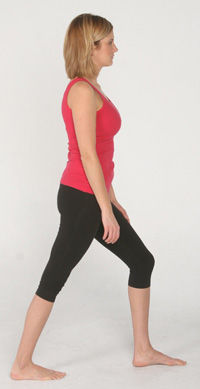
Calf Stretch
Excessive lumbar lordosis is accompanied by a forwardly rotated pelvis (i.e., an anterior pelvic tilt). This forward shift of the lumbar spine and tilt of the pelvis tips an individual’s entire body weight forward. This disruption in balance requires the calf muscles to work harder to stop the body from toppling forward. Stretching the calf muscles (in particular the gastrocnemius) helps shift the body weight back into the heels and allows the pelvis to posteriorly rotate and the lumbar spine to flex more effectively. This can help reduce some of the symptoms associated with excessive lumbar lordosis (Kendall et. al, 2005).
Stand with the feet facing forward in a staggered stance (left foot forward and right foot back) and pelvis tucked under. Gently lean forward while keeping both feet in contact with the ground. Hold the stretch for 20 to 30 seconds and repeat on the other side. Pull up on the toes of the right leg to activate the anterior tibialis to progress this stretch, if needed.
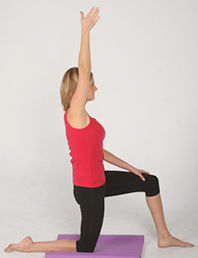
Hip-flexor Stretch
The hip flexor muscles originate on the lumbar spine, cross the pelvis and insert on the inside of the upper leg. When these muscles are tight or restricted they pull the lumbar spine forward, exacerbating excessive lumbar lordosis. Stretching the hip flexors helps release these tissues and allows the lumbar spine to flex more effectively (McGill, 2002).
Kneel down on the right knee with the left foot forward. Tuck the pelvis under to help decrease the arch in the lower back. Align the hips left to right and then gently raise the right arm. A stretch should be felt in the front of the right hip/leg. Hold the stretch for 20 to 30 seconds and repeat on the other side. Squeezing the gluteal muscles during this exercise can increase the intensity of the stretch.
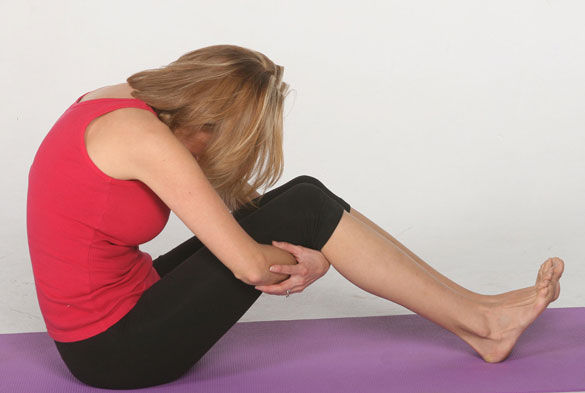
Lower-back Stretch
Excessive lumbar lordosis is characterized by an overly arched lower back and tight lumbar erector spinae muscles. Stretching the lumbar extensors helps the lumbar spine flex more effectively (Gray, 1995).
Sit on the floor with the knees bent and feet forward. Grab the backs of the knees, posteriorly tilt the pelvis and lean forward to round the lower back. Hold the stretch for 20 to 30 seconds. Progress this stretch by actively contracting the abdominal muscles.
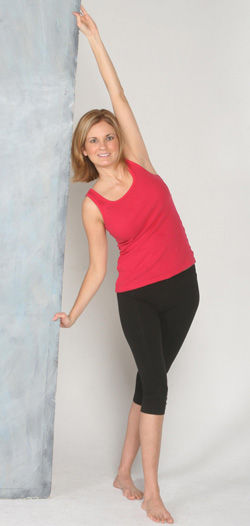
Abdominals Stretch
Excessive lumbar lordosis is accompanied by excessive thoracic kyphosis (i.e., an over-rounding of the upper back). The upper back rounds to counterbalance the overarching of the lower back to help maintain the body’s center of gravity (Kendall et al., 2005). Stretching the abdominal muscles helps promote extension in the thoracic spine, allowing the lumbar spine to relax from its overly extended position and flex more effectively.
Stand in a doorframe and reach the left arm overhead and grasp the side of the frame above head level. Place the right hand lower on the frame at thigh level and tuck the left foot behind the right foot. Push the left hip away from the hands while lifting the torso upright to stretch the left hip, abdominals and muscles around the shoulder and rib cage. Hold the stretch for 20 to 30 seconds and repeat on the other side. To progress this stretch, gently rotate the sternum away from the doorframe while preventing the hips from rotating.
Step Back With Arm Raise Stretch
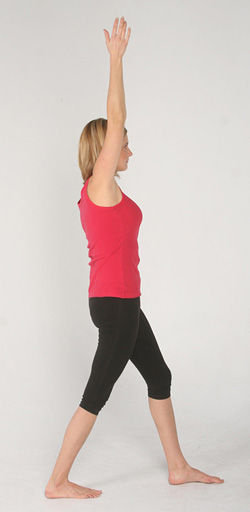
As discussed earlier, excessive lumbar lordosis is accompanied by tight calves, hip flexors, lumbar erectors and abdominals (among others) (Myers, 2001). As your client becomes proficient at stretching these muscles individually, you can combine all these body parts into the following dynamic/integrated body stretch. This type of full-body progression is the ultimate goal of your stretching program.
Step back with the right leg while raising the right arm overhead. Make sure both feet are facing forward and that the pelvis is tucked under to decrease the arch in the lower back. Keep the shoulder back and down and raise the right arm. Complete the movement on the right side by stepping forward with the right leg while bringing the right arm down. Next, step backward with the left leg and raise the left arm to complete the movement on the left side. Repeat on both sides six to 10 times.
Conclusion
Progressing a corrective exercise program from SMR exercises to strategic stretching exercises will help the client regain confidence in his or her ability to move without pain. As your client continues to improve and regain function, you can begin introducing appropriate strengthening exercises into his or her program.
Become a BioMechanics Method® Corrective Exercise Specialist
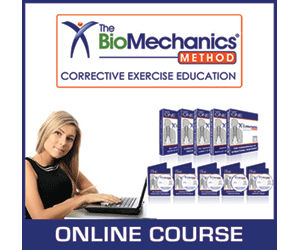
Want to learn more about how you can help your clients exercise with less pain? The BioMechanics Method® Corrective Exercise Specialist online course (TBMM-CES) is specifically designed to give fitness professionals a step-by-step process for helping clients overcome muscle and joint pain. Created by Justin Price, one of the top musculoskeletal assessment and corrective exercise experts in the world, this course will give you the postural assessment, anatomy, corrective exercise and program design skills necessary to help clients become pain free. This self-paced study course is valued at 8.0 ACE CECs and includes digital textbooks, videos and online quizzes.
References
American Council on Exercise (2014). ACE Personal Trainer Manual (5th ed.). San Diego, Calif.: American Council on Exercise.
Blahnik, J. (2011). Full-Body Flexibility (2nd ed.). Champaign, Ill.: Human Kinetics.
Kendall, F.P. et al. (2005). Muscles Testing and Function with Posture and Pain (5th ed.). Baltimore, Md.: Lippincott Williams & Wilkins.
McGill, S. (2002). Low Back Disorders: Evidence Based Prevention and Rehabilitation. Champaign, Ill.: Human Kinetics.
Myers, T. (2001). Anatomy Trains: Myofascial Meridians for Manual and Movement Therapists. Edinburgh, England: Churchill Livingstone.
Price, J. (2013). The Amazing Tennis Ball Back Pain Cure. The BioMechanics Press.
Price, J. (2010). The BioMechanics Method Corrective Exercise Educational Program. The BioMechanics Press.
Whitworth, L. et al. (2007). Co-Active Coaching: New Skills for Coaching People Toward Success in Work and Life (2nd ed.). Palo Alto, Calif.: Davies-Black Publishing.





 by
by 